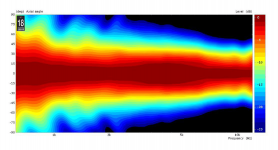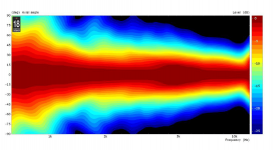"so there is no "reflection" and what comes out of the mouth is clearly "direct"
Waveguides are non diffracting horns....
The words Diffraction horn throws me because I thought a diffraction horn was only a horn that had a diffraction slot. That apparently isnt true exactly. The more I study the words Diffraction the more I can visualize it...A loading horn can be free of diffraction is what I think I know at this point lol , as well, diffraction can happen with a horn regardless if there is a slot....its just a matter of where the Diffraction occurs
Quarter wave tuning is a result of Reflections? Thats not the right question....Quarter wave tuned diffractionless horn..is this output considered a mix of direct and indirect energy???
Does this mean that the added directivity and seemingly increased radiation size of a wide baffle with woofer, does or does not belong to the class "reverberant field"?
I think with both situations horn and wide baffle, the waves are synced in time but I am not sure exactly how to define "Synced"
"But they are not synched in time and that makes all the difference" This is likely what I need to break down.... It seems that to be considered apart of the reverberant field...the wave must be delayed by at least a certain amount of time? What is that threshold?
Waveguides are non diffracting horns....
The words Diffraction horn throws me because I thought a diffraction horn was only a horn that had a diffraction slot. That apparently isnt true exactly. The more I study the words Diffraction the more I can visualize it...A loading horn can be free of diffraction is what I think I know at this point lol , as well, diffraction can happen with a horn regardless if there is a slot....its just a matter of where the Diffraction occurs
Quarter wave tuning is a result of Reflections? Thats not the right question....Quarter wave tuned diffractionless horn..is this output considered a mix of direct and indirect energy???
Does this mean that the added directivity and seemingly increased radiation size of a wide baffle with woofer, does or does not belong to the class "reverberant field"?
I think with both situations horn and wide baffle, the waves are synced in time but I am not sure exactly how to define "Synced"
"But they are not synched in time and that makes all the difference" This is likely what I need to break down.... It seems that to be considered apart of the reverberant field...the wave must be delayed by at least a certain amount of time? What is that threshold?
Last edited:
"so there is no "reflection" and what comes out of the mouth is clearly "direct"
This depends on the shape of the horn mouth, and whether the horn is mounted free-standing or in a baffle.
You could read this again:
Attachments
By the way, an exponential horn doesn't necessarily have to be synonymous with 'beaming'
Looks similar to the elliptical tractrix polars I can find...
Polars of the LTH142.
For anyone interested the explanation behind those images is hereBy the way, an exponential horn doesn't necessarily have to be synonymous with 'beaming'.
https://www.researchgate.net/publication/342159779_Hybrid_Constant_Directivity_Horn
Polars of the LTH142.
Those of the XT1464 are similar.
Wrt loading vs directivity vs smoothness, both are still (among) the best commercially available horns.
Attachments
By ground plane, you are referring to the measuring technique described here: Loudspeaker Ground - Plane Measurement ?The ground plane with have a strong detrimental effect. Best on a pole or stand. I had a marked rotating platform to note angles.
The link is broken so I am not sure what method you are referencing.
There are right and wrong ways to do ground plane.
The right way is a pit into which the system is installed such that it points up in an truly infinite baffle. Microphone is in the air above.
Placing the system on the ground with the microphone also on the ground is not really correct since there is a lot of absorption as the wave travels across the ground and you are really measuring two systems stacked on top of one another.
Not putting the microphone on the ground is the worst situation and will not yield anything like the real directivity.
There are right and wrong ways to do ground plane.
The right way is a pit into which the system is installed such that it points up in an truly infinite baffle. Microphone is in the air above.
Placing the system on the ground with the microphone also on the ground is not really correct since there is a lot of absorption as the wave travels across the ground and you are really measuring two systems stacked on top of one another.
Not putting the microphone on the ground is the worst situation and will not yield anything like the real directivity.
I'm sorry for the broken link, please see : http://www.mh-audio.nl/Acoustics/Groundplane.html
Erin shows good correlation between ground plane measurements and NFS measurements in this thread, also that as frequency goes up the surface of the ground plane becomes much more critical as Earl points out above
https://www.diyaudio.com/community/...-close-enough-to-anechoic.353347/post-6184626
https://www.diyaudio.com/community/...-close-enough-to-anechoic.353347/post-6184626
I dont know how I missed this but 🤣🤣🤣Yeah, beaming and pattern flip never goes completely out of style
Axial would be best, because the polars would be very wrong, unless you had a way to subtract the reflections from the ground plane.Erin shows good correlation between ground plane measurements and NFS measurements
You can determine the dimensions of a room or distance to a boundary required to obtain ‘anechoic’ data to a specific frequency. It’s based on the source and microphone positions, which should be chosen to ensure that the device is in the far-field, if you don’t have a fancy $100k tool like the Klippel NFS 😀
You also have to be relatively careful when choosing the point of rotation, as the acoustic centre and acoustic origin may move farther from or closer to the mic at each measurement position.
This is a very good read, with some simple maths to figure out the limits of your living room, or garden, or whatever:
https://www.audiomatica.com/wp/wp-content/uploads/appnote_002.pdf
Chapter 12 of the CLIO manual is good for single plane polar data gathering methodology, too:
https://www.audiomatica.com/wp/wp-content/uploads/clioman125.pdf
You also have to be relatively careful when choosing the point of rotation, as the acoustic centre and acoustic origin may move farther from or closer to the mic at each measurement position.
This is a very good read, with some simple maths to figure out the limits of your living room, or garden, or whatever:
https://www.audiomatica.com/wp/wp-content/uploads/appnote_002.pdf
Chapter 12 of the CLIO manual is good for single plane polar data gathering methodology, too:
https://www.audiomatica.com/wp/wp-content/uploads/clioman125.pdf
Groundplane method is usually interesting for frequencies below 200Hz. It will give a wrong picture with higher frequencies especially when you take diffraction etc into consideration.The link is broken so I am not sure what method you are referencing.
There are right and wrong ways to do ground plane.
The right way is a pit into which the system is installed such that it points up in an truly infinite baffle. Microphone is in the air above.
Placing the system on the ground with the microphone also on the ground is not really correct since there is a lot of absorption as the wave travels across the ground and you are really measuring two systems stacked on top of one another.
Not putting the microphone on the ground is the worst situation and will not yield anything like the real directivity.
The absorption of those lower frequencies is very minimal, but an hard surface is best.
The rest can be done with just a time-window measurement.
In fact a nearfield with simulated bafflestep stitched with farfield time windowed measurements is in most case enough.
But hell, why not all three methods?
Doesn't take that much time (yes I have done it multiple times)
Needs to be rotating on the edge of the front baffle, otherwise the distance won't be constant.The ground plane with have a strong detrimental effect. Best on a pole or stand. I had a marked rotating platform to note angles.
- Home
- Loudspeakers
- Multi-Way
- Is it possible to cover the whole spectrum, high SPL, low distortion with a 2-way?

